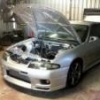Gtr Intercoolers? Trust? Just Jap?..........
Announcements
-
Similar Content
-
Latest Posts
-
By Murray_Calavera · Posted
As GTS mentioned, it takes a bit of faffing, some fiddling and a little modifying. With the strainers, you can buy different styles. Some sit flat on the pump, some angle down. Here are some photos of mine, ignore the ugly welds lol. -
The smart thing is to actually locate the pump at the right point down the hanger, so that the strainer can stay sticking out at a right angle, but near the bottom. This is the perpetual hassle with retrofitting any different pump to the factory hanger. Some just go where you need it to, some need fiddling and faffing, and modifying of stuff.
-
Some updates. After a lot of praying and some inspecting of crank threads, we've found that they were both kinda munted but nothing seemed terminal. The other option was drilling and helicoiling the crank. That is obviously the last option so we decided to at least try to get a OEM GM bolt in to GM Specs. So after honing/linishing the balancer from it's .002" interference fit to a .0018" to .0015" to .0013" it eventually slotted on to the crank. ATI state the interference is nominally 0.0007-0.0009... so it's still snugger than ATI reckon and explains the issues we had to fit the thing to begin with. New GM bolt went in at 37 ft/lb then torqued 140 degrees after which was EXTREMELY but it tightened up to 140 degrees and it was a lot of force. So all things considered, the balancer is secured to the exact specs that GM want with the OEM Stretch bolt, (that ATI say you can use..) and the balancer itself is seated and snug AF. So WOO. Engine is now back in the car with lots of swearing. Bellhousing bolts done up, driver side manifold is on, AC Compressor and hard lines are back on the car. Next step will be to connect various engine bits/wiring/intake/radiator etc. Then oil and coolant and ... test start it? And of course, looking into this issue... which actually doesn't look so bad - It looks like it can be twisted back into shape with a set of multigrips. Anyone wanna buy my bonnet? Boy it looks good over there and sunk cost sucks.
-
Also this may be a stupid question, but how would you recommend getting the strainer on a downwards angle ? as they tend to obviously clip to the bottom of the pump which usually sits level 🥴
-





Recommended Posts
Create an account or sign in to comment
You need to be a member in order to leave a comment
Create an account
Sign up for a new account in our community. It's easy!
Register a new accountSign in
Already have an account? Sign in here.
Sign In Now